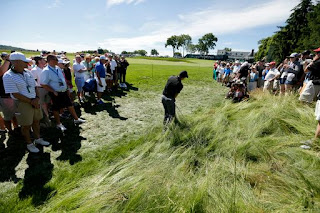So here we are on the 20th June, the longest day and the start of the British summer. There is talk of a Strawberry moon, the tennis at Wimbledon is around the corner, final Open qualifying is under way & the Euro's continue to delight/frustrate (delete as appropriate...)
On the golf course the forecast for the day was poor, and the forecasters were spot on.
I thought this would provide a good opportunity to look at how some of the surfaces around the golf course cope with heavy rain downpours.
To begin with amounts, from 7am this morning we had 18mm of rain until 2pm. Compare this with the June average rainfall of 54.2mm, we had nearly a third of the months average rainfall in 7 hour's. Obviously the surfaces are going to be wet. The question I'm interested in is how quickly the water moves off the surface & then how quickly the water moves through the profile.
The way to get good infiltration rates, the rate at which water moves off the surface, is to have good grass sward coverage, reduce thatch levels and create & maintain a well aerated rootzone. Ways we strive to achieve these conditions on the playing surface's are sound agronomic practice's including aeration & top dressing.
Once water has begun to move off the surface the ease & rate at which it moves through the profile is determined by the underlying soils & the drainage capabilities of the soils.
As Muswell Hill golf course is built on heavy clay soils we need to install drainage systems to help dry out the surfaces. The recent greens drainage works carried out are helping the percolation rates of water being able to move through the profile which will help us to provide drier playing surfaces.
On the golf course the forecast for the day was poor, and the forecasters were spot on.
I thought this would provide a good opportunity to look at how some of the surfaces around the golf course cope with heavy rain downpours.
To begin with amounts, from 7am this morning we had 18mm of rain until 2pm. Compare this with the June average rainfall of 54.2mm, we had nearly a third of the months average rainfall in 7 hour's. Obviously the surfaces are going to be wet. The question I'm interested in is how quickly the water moves off the surface & then how quickly the water moves through the profile.
The way to get good infiltration rates, the rate at which water moves off the surface, is to have good grass sward coverage, reduce thatch levels and create & maintain a well aerated rootzone. Ways we strive to achieve these conditions on the playing surface's are sound agronomic practice's including aeration & top dressing.
Once water has begun to move off the surface the ease & rate at which it moves through the profile is determined by the underlying soils & the drainage capabilities of the soils.
As Muswell Hill golf course is built on heavy clay soils we need to install drainage systems to help dry out the surfaces. The recent greens drainage works carried out are helping the percolation rates of water being able to move through the profile which will help us to provide drier playing surfaces.
We can compare this to images of the 17th green below, taken at the same time that show more surface puddling, meaning it's taking the water longer to work through the profile as the soils stay wetter for longer.





















